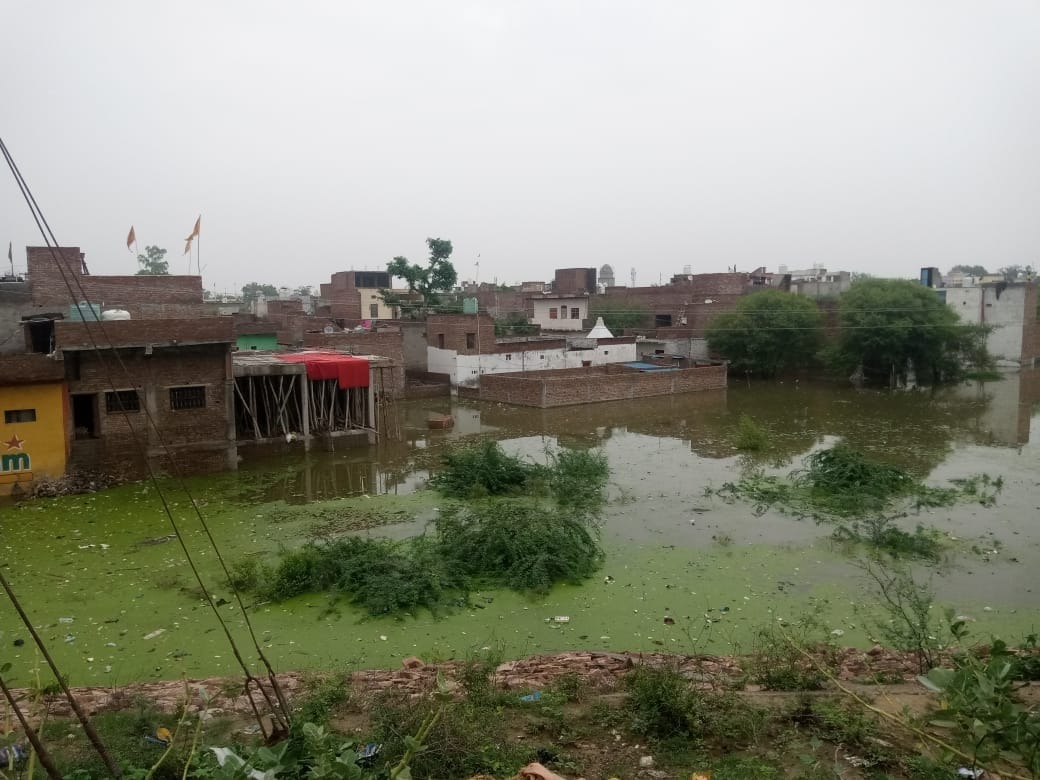Prashant Kumar Mishra, J
1. The four appellants before us have been convicted for committing murder of deceased Jagrakhan Sahu during the period 16.00 hours to 9.16 hours
of 29.10.2009 to 9 am of 30.10.2009 near Dokrabhata Gharsa Road, beneath Paththarra Nala Bridge, Gai Ghat, Village Padmavatipur.
2. (PW-10) Gautam Janghel (Lodhi) informed the concerned police over telephone at 13.35 hours on 30.10.2009 that dead body of Jagrakhan Sahu is
lying near Dokrabhata Gharsa Road, beneath Paththarra Nala Bridge, Gai Ghat. When the police reached the spot, (PW-4) Ganesh, son of Jagrakhan
lodged Dehati Merg Intimation to the effect that at 16.00 hours on 29.10.2009 Jagrakhan had gone alone to Padmavatipur market but did not come
back. Offence under Section 302 of the IPC was registered under Dehati Nalishi and thereafter FIR (Ex.-P/40) was registered. At the place of
occurrence itself, one blood stained white towel, one torn vest (Baniyan), steel hook, button of trouser, plastic wrapper etc. along with blood stained
soil were recovered. Autopsy was conducted by PW-19 Dr. Leela Ramteke, who submitted the postmortem report (Ex.-P/33) opining that the death
is homicidal in nature.
3. During further investigation, memorandum statements of the accused persons were recorded vide Ex.-P/18, P/19, P/20 & P/21 for Siya Ram,
Ishwar, Bahurdas and Arjun respectively on 31.10.2009 and thereafter recovery of one plastic bag was made from Bahurdas vide Ex.-P/22, one pair
of plastic slipper from Ishwar vide Ex.-P/23, one wrist watch from Siya Ram vide Ex.-P/24 and beads of plastic necklace were recovered from Arjun
vide Ex.-P/25. The articles were identified by the son of the deceased Ganesh (PW-4). After recording case diary statements of witnesses under
Section 161 CrPC, charge sheet was filed.
4. In course of trial, the prosecution examined 20 witnesses to bring home the guilt of the appellants. The trial Judge has convicted the appellants
mainly on the evidence of memorandum statements and consequent seizure of articles vide Ex.-P/18 to P/25. The trial Court has also discussed the
evidence of PW-5 Manohar Rajak, PW-13 Mahadev Netam and PW-17 Bisal Gandharv, who have seen Siya Ram moving near the place of incident
in the late evening of 29.10.2009 where the dead body of the deceased was recovered. The trial Court has found corroboration from the evidence of
PW-11 Dev Singh Lodhi, who had met the deceased nearby village weekly market and had consumed tea together in a small restaurant.
5. Shri PKC Tiwari, learned Senior Advocate duly assisted by Shri Shashi Bhushan and Shri Ashutosh Trivedi, Advocates would submit that
conviction is based on wholly inadmissible evidence, therefore, it deserves to be set aside. Referring to the evidence of PW-4 Ganesh, it is argued that
the memorandum statements and recovery of articles have not been proved in accordance with law, therefore, the memorandums and consequent
recovery are not incriminating evidence against the appellants.
6. Per contra, Shri Arvind Dubey, learned Panel Lawyer would support the impugned conviction.
7. Before proceeding to analyze the evidence, we deem it appropriate to refer the principles under which conviction on the basis of circumstantial
evidence is permissible.
8. In the matter of Sharad Birdhichand Sarda vs State of Maharashtra, AIR 1984 SC 1622, the Supreme Court has underlined the conditions, which
must be fulfilled for convicting an accused on the basis of circumstantial evidence and held in para-152 as under:
152. A close analysis of this decision would show that the following conditions must be fulfilled before a case against an accused can be said to be
fully established :
(1) the circumstances from which the conclusion of guilt is to be drawn should be fully established.
It may be noted here that this Court indicated that the circumstances concerned 'must or should' and not 'may be' established. There is not only a
grammatical but a legal distinction between 'may be proved' and 'must be or should be proved' as was held by this Court in Shivaji Sahebrao Bobade
Vs. State of Maharashtra, (1973) 2 SCC 793 : (AIR 1973 SC 2622) where the following observations were made:
'certainly, it is a primary principle that the accused must be and not merely may be guilty before a Court can convict and the mental distance between
'may be' and must be' is long and divides vague conjectures from sure conclusions.' (2) the facts so established should be consistent only with the
hypothesis of the guilt of the accused, that is to say, they should not be explainable on any other hypothesis except that the accused is guilty.
(3) the circumstances should be of a conclusive nature and tendency.
(4) they should exclude every possible hypothesis except the one to be proved, and (5) there must be a chain of evidence so complete as not to leave
any reasonable ground for the conclusion consistent with the innocence of the accused and must show that in all human probability the act must have
been done by the accused.
9. In a very recent judgment, in the matter of Navaneethakrishnan vs State by Inspector of Police 1, the Supreme Court has held thus in paras 14 &
23:-
14. In the present case, there is no witness of the occurrence and it is only based on circumstantial evidence. Before moving further, it would be
apposite to refer the law regarding reliability of circumstantial evidence to acquit or convict an accused. The law regarding circumstantial evidence
was aptly dealt with by this Court in Padala Veera Reddy vs. State of Andhra Pradesh and Others 1989 Supp. 2 SCC 706 wherein this Court has
observed as under:-
10. x x x x (1) The circumstances from which an inference of guilt is sought to be drawn, must be cogently and firmly established;
(2) those circumstances should be of a definite tendency unerringly pointing towards guilt of the accused;
(3) the circumstances, taken cumulatively, should form a chain so complete that there is no escape from the conclusion that within all human
probability the crime was committed by the accused and none else; and (4) the circumstantial evidence in order to sustain conviction must be complete
and incapable of explanation of any other hypothesis than that of guilt of the accused and such evidence should not only be consistent with the guilt of
the accused but should be inconsistent with his innocence.
23. The law is well settled that each and every incriminating circumstance must be clearly established by reliable and clinching evidence and the
circumstances so proved must form a chain of events from which the only irresistible conclusion about the guilt of the accused can be safely drawn
and no other hypothesis against the guilt is possible. In a case depending largely upon circumstantial evidence, there is always a danger that conjecture
or suspicion may take the place of legal proof. The court must satisfy itself that various circumstances in the chain of events must be such as to rule
out a reasonable likelihood of the innocence of the accused.
When the important link goes, the chain of circumstances gets snapped and the other circumstances cannot, in any manner, establish the guilt of the
accused beyond all reasonable doubt. The court has to be watchful and avoid the danger of allowing the suspicion to take the place of legal proof for
sometimes, unconsciously it may happen to 1 AIR 2018 SC 2027 be a short step between moral certainty and legal proof. There is a long mental
distance between ""may be true"" and ""must be true"" and the same divides conjectures from sure conclusions. The Court in mindful of caution by the
settled principles of law and the decisions rendered by this Court that in a given case like this, where the prosecution rests on the circumstantial
evidence, the prosecution must place and prove all the necessary circumstances, which would constitute a complete chain without a snap and pointing
to the hypothesis that except the accused, no one had committed the offence, which in the present case, the prosecution has failed to prove.
10. In the case at hand, admittedly, case of the prosecution is based on circumstantial evidence as there is no ocular version to the incident. It is also
not disputed that the prosecution has not put forth any evidence of extra judicial confession neither weapon of offence has been recovered from any
of the appellants. The only evidence through which the appellants have been tried to be connected with the offence is the so called evidence of last
seen together and recovery of articles consequent to memorandum statements of the appellants.
11. On conjoint reading of the evidence of PW-5 Manohar Rajak, PW-13 Mahadev Netam, PW-17 Bisal Gandharv and PW-11 Dev Singh Lodhi, it
would emerge that it was PW-11 Dev Singh who was in the company of the deceased in the late evening of 29.10.2009 in the nearby village weekly
market and there is no evidence to the effect that any of the witnesses have seen the present appellants in the company of the deceased either in the
village weekly market or at the place of occurrence. Merely because the appellants also happen to be present near the bridge where the dead body of
the deceased was found on the next morning, it cannot be presumed that appellant Siya Ram has committed murder. Even this evidence is not against
other appellants except Siya Ram. So far as evidence of memorandum statements and consequent seizure of plastic bag, plastic slipper, wrist watch
and beads are concerned, PW-4 Ganesh has clearly admitted in his cross- examination that these articles were in possession of the police at the time
when inquest of dead body was prepared on 30.10.2009. Thus the articles having already been discovered and in possession of the police a day prior
to the recovery, it is not a case where the recovery was made on the basis of disclosure statements of the appellants.
12. Except the above circumstantial evidence, there is no other incriminating circumstance put forth by the prosecution to bring home the guilt of the
appellants. The circumstance sought to be used against the appellants for nailing them for committing offence under Section 302 of the IPC is
extremely weak and does not amount to legally admissible evidence for sustaining conviction.
13. After carefully analyzing the evidence, we are convinced with the arguments raised by the appellants that the present is a case of no evidence
against the appellants. The trial Court has committed serious error of law by convicting the appellants for committing murder of the deceased.
14. For the foregoing, the Appeal deserves to be and is hereby allowed. Conviction and sentence imposed on the appellants under Sections 302 and
201 of the IPC are set aside and they are acquitted of the said charges. The appellants are on bail. Surety and personal bonds earlier furnished at the
time of suspension of sentence shall remain operative for a period of 6 months in view of the provisions of Section 437-A of the Cr.P.C. The
appellants shall appear before the higher Court as and when directed. The fine amount deposited by the appellants shall be refunded to them.

